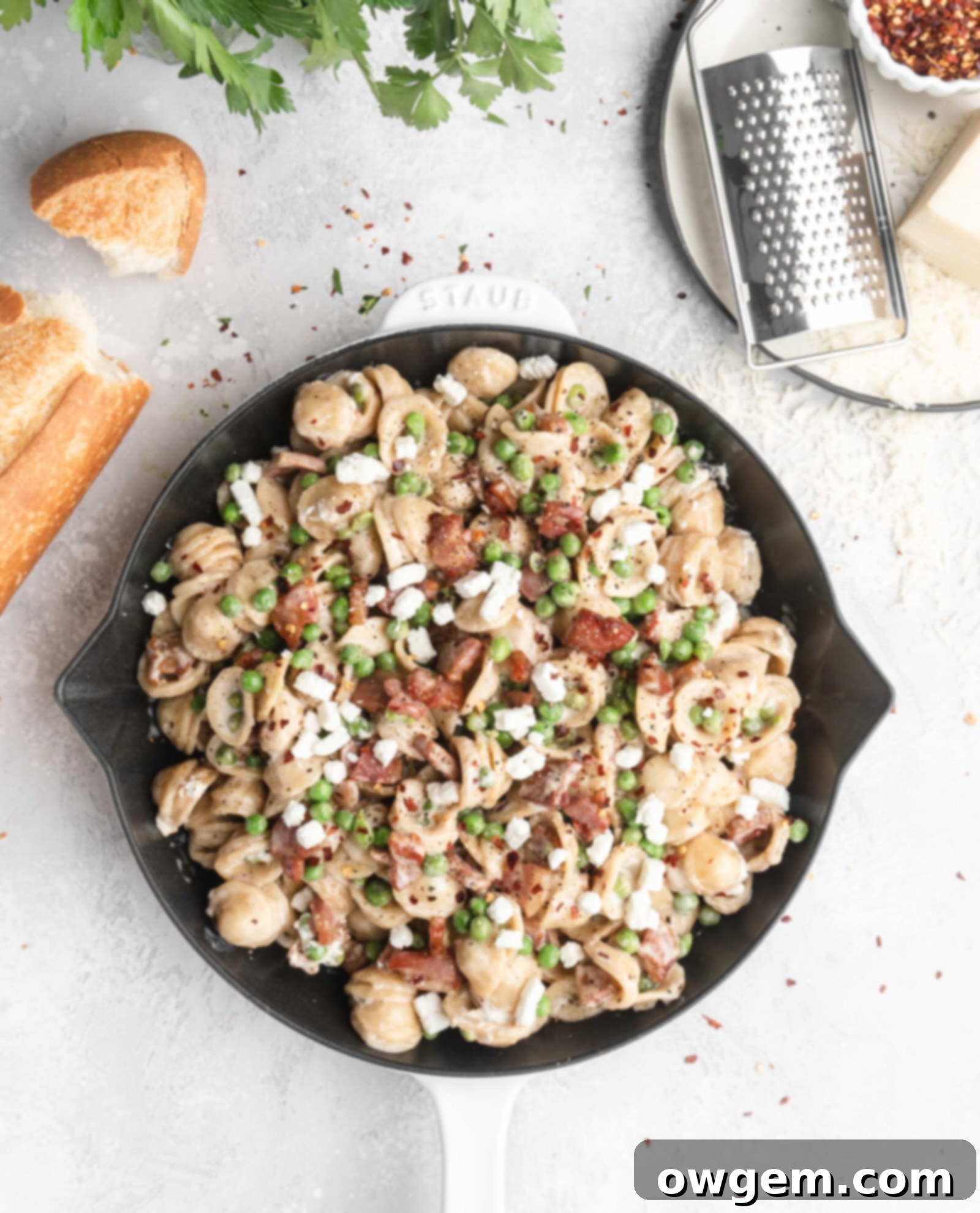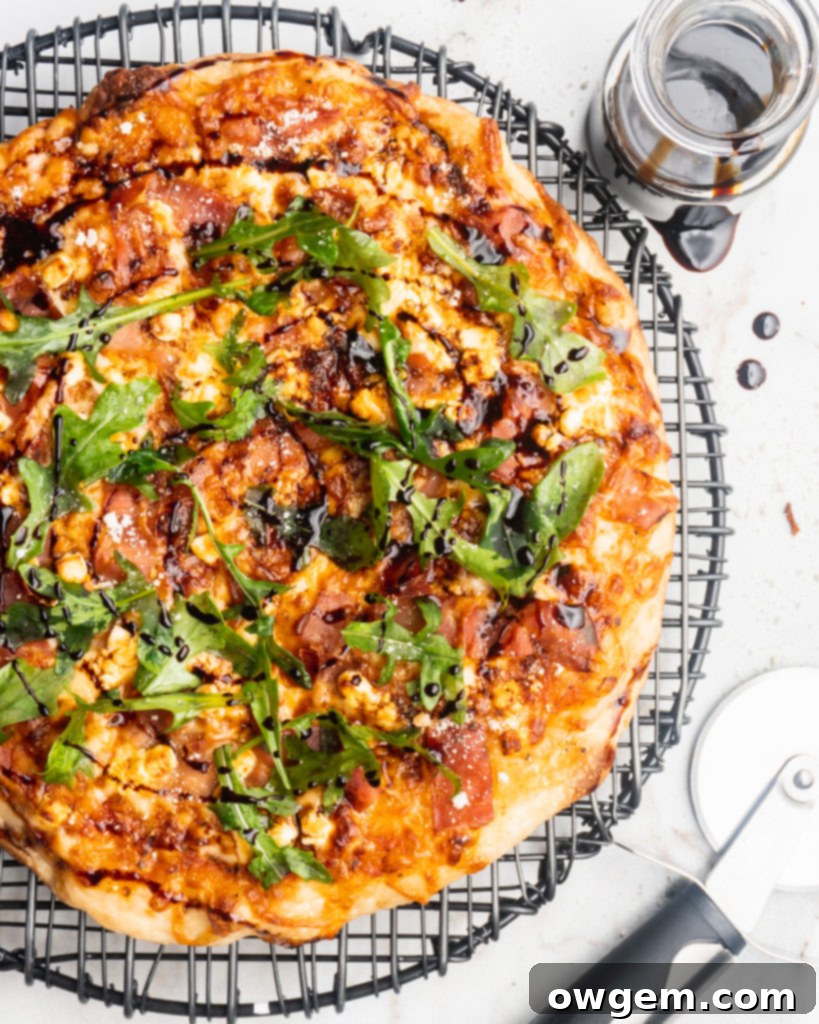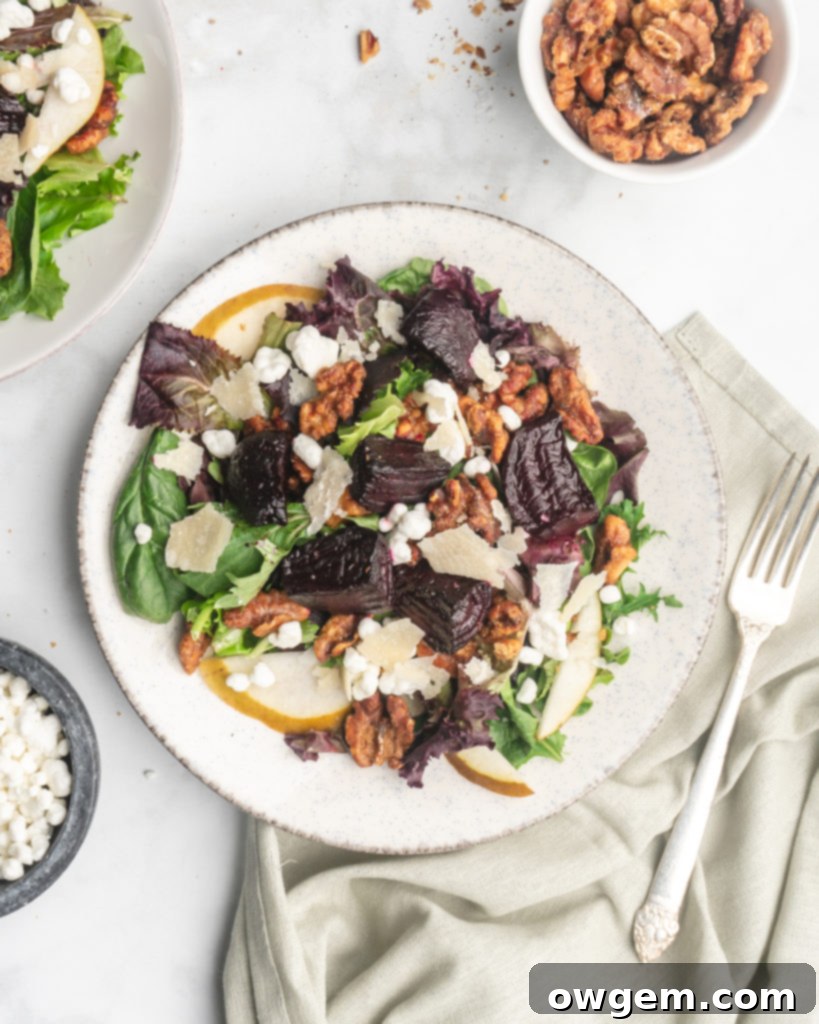Indulge in Creamy Pancetta and Goat Cheese Pasta: A Quick & Flavorful Weeknight Delight
Experience a symphony of flavors with this exquisite Pancetta & Goat Cheese Pasta, a dish that masterfully balances savory, salty, sweet, and tart notes. Designed for both busy weeknights and special occasions, this recipe requires minimal ingredients and astonishingly cooks up in less than 15 minutes! Each forkful delivers the irresistible crunch of salty, savory pancetta and the bright sweetness of petite peas, all enveloped in a luxurious, creamy garlic-wine sauce. The experience is elevated further with a generous topping of two distinct cheeses: umami-rich Parmesan and wonderfully tangy goat cheese. This harmonious blend of textures and tastes creates a truly well-rounded and immensely satisfying meal that will quickly become a cherished favorite in your culinary repertoire.
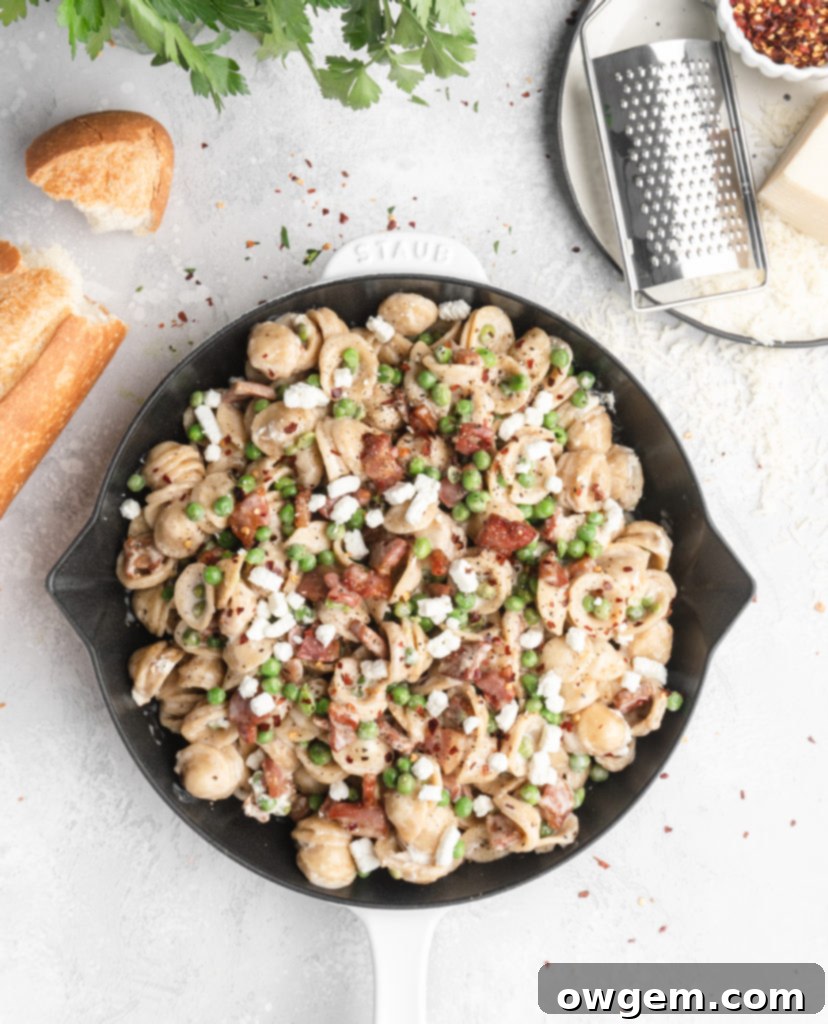
Understanding Pancetta: The Star Ingredient of Your Pasta Dish
Pancetta, an Italian delicacy, is essentially cured pork belly, often described as the unsmoked cousin of bacon. Its flavor profile is intensely salty and profoundly savory, contributing a deep umami essence to any dish. When fried, its texture becomes delightfully crispy, strikingly similar to perfectly cooked bacon. Typically sold in a cylindrical log, pancetta is then sliced and has a notably high fat content. This high fat content is crucial for a cooking process known as rendering, where the fat slowly melts out of the meat. The rendered fat, imbued with rich pork flavor, forms an incredibly aromatic and flavorful base for sauces and other culinary creations. In this Pancetta and Goat Cheese Pasta, the pancetta is pan-fried to golden crispness, and its flavorful rendered fat is cleverly utilized as the foundation for our luxurious, creamy pasta sauce. This method ensures that every spoonful of sauce is packed with a robust, meaty, savory depth that elevates the entire dish.
You’ll find pancetta readily available at the deli counter of most well-stocked grocery stores. When purchasing, I typically request slices about ¼ inch thick. Upon returning home and preparing for the recipe, I dice these slices into small, manageable cubes, roughly ½ inch long by ½ inch wide by ¼ inch thick. This size ensures each piece becomes perfectly crispy and distributes evenly throughout the pasta. If pancetta isn’t available or if you’re looking for a convenient alternative, high-quality bacon can be used as a substitute. Keep in mind that bacon will introduce a smoky flavor to the dish, which can be a delicious variation if you enjoy that profile. Another excellent, more traditional Italian substitute is guanciale, cured pork jowl, which offers an even richer, melt-in-your-mouth texture and intense flavor. Whichever you choose, ensure it’s prepared properly to maximize flavor and texture.
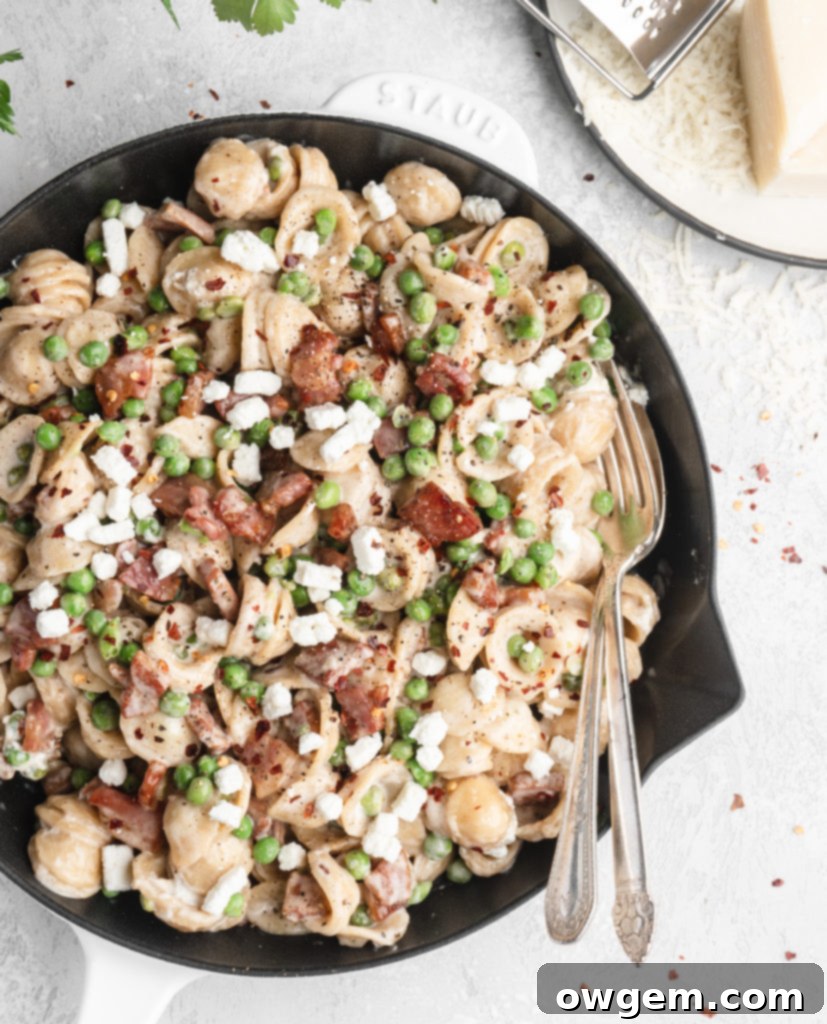
Selecting the Perfect White Wine for Your Creamy Pasta Sauce
In most culinary applications, particularly for savory sauces, the conventional wisdom suggests using a dry white wine. The rationale is simple: dry wines prevent any undesirable sweetness from permeating the dish. As wine is reduced during cooking, its inherent flavors and sugars become concentrated. A sweet wine, when reduced, would become even sweeter, often resulting in an imbalance for savory recipes. Common dry white wines suitable for cooking include Sauvignon Blanc, Pinot Grigio, and unoaked Chardonnay, offering crisp acidity and subtle fruit notes that deglaze the pan and add complexity without overpowering other ingredients.
However, this Pancetta and Goat Cheese Pasta recipe boldly presents an intriguing exception to the dry wine rule! The unique flavor profile of this dish, with its tart goat cheese, actually harmonizes beautifully with a slightly sweeter wine. I have personally experimented with both a classic dry white, such as Sauvignon Blanc, and a sweeter varietal like Moscato, and both yielded absolutely wonderful results. When using a dry white, the sauce develops a more traditional, sophisticated wine-sauce flavor, characterized by bright acidity and herbaceous notes. Conversely, incorporating a sweeter white wine, such as Moscato, lends a delicate, subtle sweetness to the sauce that creates a magnificent counterpoint to the piquant, tangy goat cheese. This delightful interplay of sweet and tart elevates the dish to another level of gastronomic pleasure.
A slight but important caveat exists when opting for a sweeter wine like Moscato: look for a wine with a higher alcohol percentage (ABV). I achieved excellent results using a Moscato with a 12.5% ABV. In my experience, Moscato varieties with a lower ABV, typically ranging from 8-10%, tend to be much too sweet, potentially making the sauce cloying rather than delicately balanced. The higher alcohol content helps to cut through some of the sweetness during reduction, allowing the desired subtle fruit notes to shine without overwhelming the dish. Ultimately, the choice between a dry or slightly sweeter wine allows for a lovely customization of this already fantastic pasta, catering to your personal taste preferences while maintaining its inherent deliciousness.
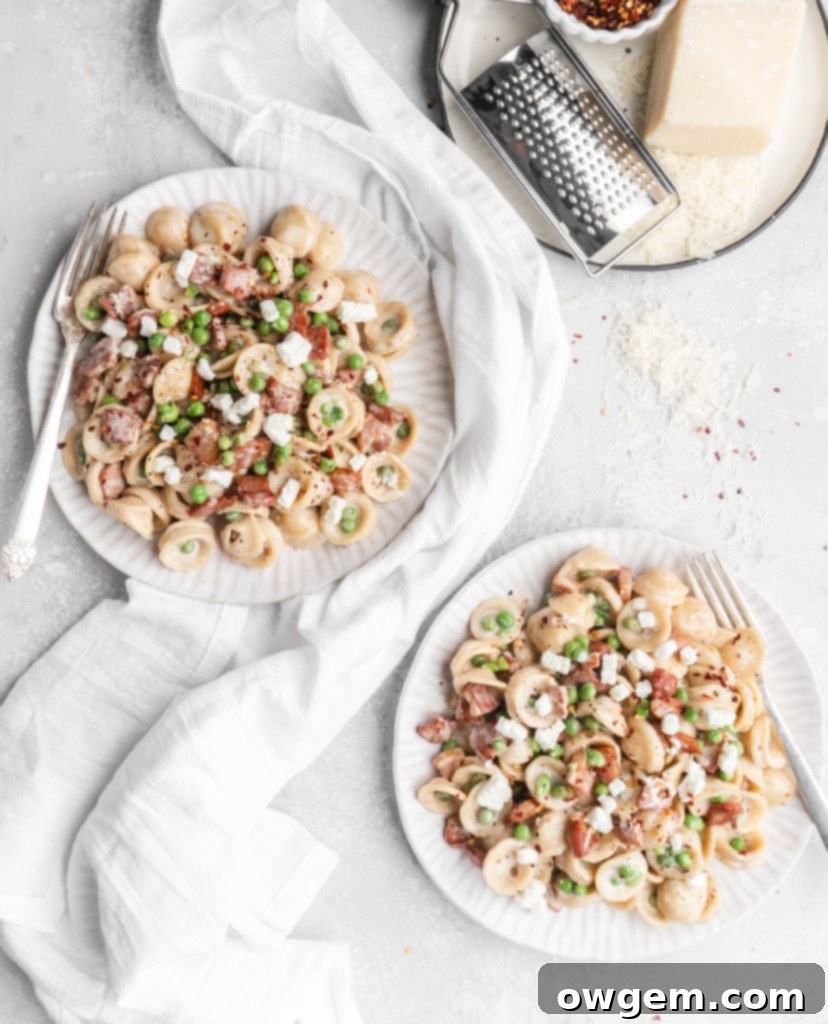
Crafting Your Pancetta and Goat Cheese Pasta: A Step-by-Step Guide
Embark on the journey of creating this delectable Pancetta and Goat Cheese Pasta by first setting the stage for your flavorful sauce. Begin by melting one teaspoon of butter in a large, sturdy pan over medium heat. As the butter gently foams and begins to slightly bubble, signaling it’s perfectly heated, add your diced pancetta. Allow the pancetta to fry undisturbed for a few minutes, turning occasionally, until each piece achieves a beautiful golden-brown color and a satisfying crisp texture, reminiscent of perfectly fried bacon bits. Once crispy, carefully remove the pancetta from the pan using a slotted spoon and transfer it to a plate lined with a paper towel. This allows any excess rendered fat to be absorbed, ensuring your pancetta remains delightfully crisp. Next, drain approximately half of the rich, rendered pancetta fat from the pan, leaving just enough to coat the bottom. Return the pan to the heat, then add the minced garlic and a pinch of red pepper flakes. Sauté these aromatics for about 1 minute, or until the garlic becomes fragrant and lightly golden, being careful not to burn it. The scent will be truly intoxicating. Now, it’s time to introduce the wine; pour it into the pan and allow it to simmer vigorously. Let the wine reduce by half, a process that typically takes about 2 minutes, intensifying its flavors and deglazing the pan by incorporating all those delicious browned bits from the bottom. Finally, stir in the heavy cream and frozen peas. Bring the sauce to a gentle boil, then reduce the heat to a simmer and let it cook for approximately 3-4 minutes, allowing it to thicken to a luscious, creamy consistency.
With your exquisite sauce ready, it’s time to unite it with the pasta. Add your freshly cooked pasta directly into the pan with the sauce and toss thoroughly, ensuring every strand is beautifully coated. Next, sprinkle in the grated Parmesan cheese, tossing again to melt it into the sauce and further enhance its creaminess. To achieve the perfect glossy finish and ensure the sauce adheres wonderfully to the pasta without becoming dry, slowly add just enough reserved pasta water, a splash at a time, until the desired consistency is reached. The starchy pasta water is key here, helping to emulsify the sauce and create that coveted smooth texture. To complete this culinary masterpiece, reintroduce the crispy pancetta to the pan, and give it one last gentle toss to distribute. Finally, crown each serving with generous crumbles of soft goat cheese, season with freshly ground salt and black pepper to taste, and perform a final, delicate toss before serving immediately. This ensures all the flavors are perfectly melded and the goat cheese begins to soften slightly from the pasta’s warmth, adding a delightful creaminess and tang.
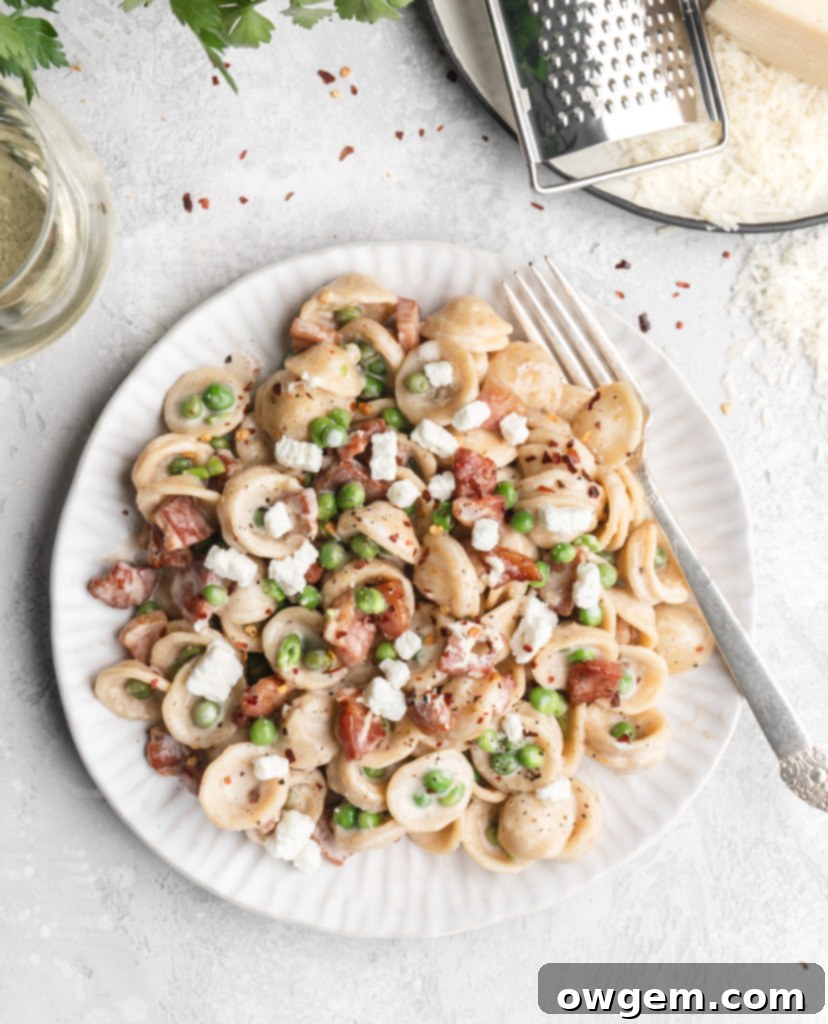
Mastering the Art of Pasta and Sauce Synchronization
Achieving culinary perfection in a pasta dish often hinges on precise timing, specifically aiming to have both your pasta and sauce complete at the exact same moment. This synchronization ensures that the pasta is perfectly al dente, firm to the bite, and ready to absorb the luscious sauce without becoming overcooked. To accomplish this, always consult your pasta box for its suggested cooking time. This crucial piece of information will guide your strategy for when to begin boiling your pasta. For instance, if your sauce takes approximately 12 minutes to prepare, as this Pancetta and Goat Cheese Pasta sauce does, and your chosen pasta requires 8-10 minutes to cook, you would start the pasta a few minutes after you begin the sauce. This allows them to finish simultaneously, creating a harmonious dish where every component is at its peak.
While simultaneous completion is the ideal scenario, if a slight timing discrepancy occurs, it is always preferable for your sauce to be ready a few minutes before the pasta. A completed sauce can comfortably sit on very low heat, perhaps with an occasional stir, without compromising its quality. In contrast, cooked pasta is far more delicate. If left to sit, even for a short period, it will continue to cook from its residual heat, quickly transitioning from al dente to soft, mushy, and undesirable. Pasta cooking times can vary significantly, ranging from as little as 3 minutes for fresh pasta or very thin varieties, up to 15 minutes for thicker or larger shapes. Therefore, it is paramount to accurately gauge the cooking time of your pasta and plan its start time in careful contrast to your sauce’s preparation time. This thoughtful approach ensures the best possible texture and flavor for your final Pancetta and Goat Cheese Pasta dish, making your efforts truly shine.
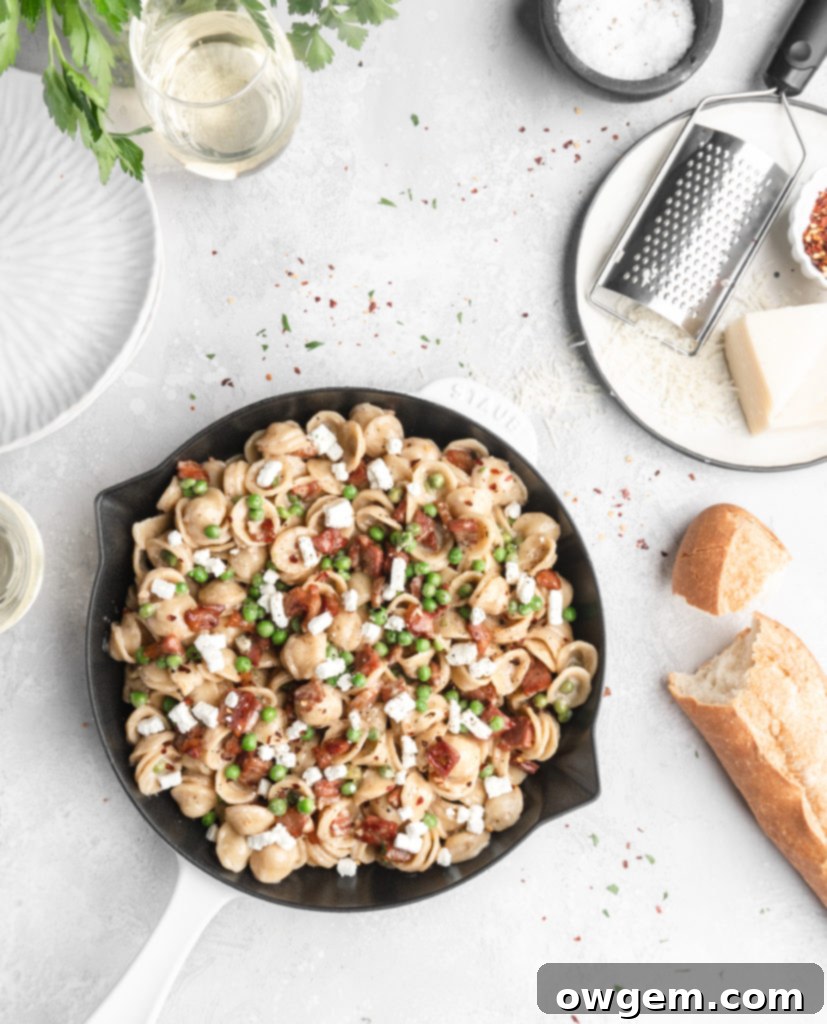
Pancetta and Goat Cheese Pasta: Creative Substitutions and Flavorful Variations
This versatile Pancetta and Goat Cheese Pasta recipe is incredibly adaptable, allowing for a range of substitutions and variations to suit different tastes or dietary needs. Here are some ideas to customize your dish:
- Pancetta Alternatives: As mentioned, both bacon and guanciale are excellent substitutes for pancetta. Bacon will lend a smoky depth that can be quite appealing, offering a different but equally delicious flavor profile. Guanciale, on the other hand, provides a richer, more unctuous texture and an intense pork flavor that is closer to traditional Italian preparations.
- Goat Cheese Options: While the tart and creamy goat cheese is a highlight of this dish, it’s perfectly fine to omit it if you’re not a fan. The pasta will remain incredibly delicious and satisfying even without it, offering a purer expression of the creamy pancetta and pea sauce. Alternatively, if you want a similar tang but a different texture, consider a crumbled feta cheese or even a dollop of mascarpone for extra creaminess without the strong goat cheese flavor.
- Wine-Free Sauce: If you prefer to cook without alcohol, chicken stock or vegetable broth can be used as a direct substitute for the white wine. While the flavor profile will be slightly different – losing some of the acidic brightness and complexity that wine provides – the stock will still contribute a savory base and aid in deglazing the pan, resulting in a rich and flavorful sauce.
- Pasta Shape Flexibility: This recipe is incredibly forgiving when it comes to pasta shapes. Any short pasta variety will work beautifully, allowing the creamy sauce to cling to every nook and cranny. Orecchiette, as suggested, is fantastic, but penne, rigatoni, fusilli, or even cavatappi would be equally delightful choices. Choose your favorite short pasta for the best eating experience.
- Adding More Vegetables: Feel free to boost the nutritional content and add more texture by incorporating other quick-cooking vegetables. Spinach or baby kale can be wilted into the sauce just before adding the pasta, or finely diced zucchini or bell peppers could be sautéed with the garlic.
- Herbal Freshness: A sprinkle of fresh herbs like chopped parsley, chives, or basil at the very end can add a burst of freshness and aroma, brighteng up the rich sauce.
Don’t be afraid to experiment with these variations to make this Pancetta and Goat Cheese Pasta truly your own!
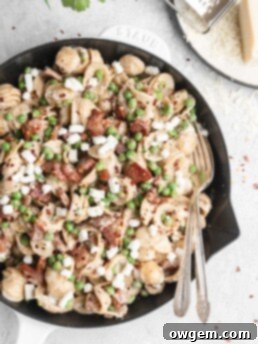
Get the Recipe:
Pancetta & Goat Cheese Pasta
Pin
Rate
Ingredients
- 12 oz (340g) Short Pasta Variety , (I used orecchiette)
- 1 cup Reserved Pasta Water
- 1 tsp Butter
- 150 g Pancetta,, cubed small
- 4 Garlic Cloves,, crushed or minced
- Pinch of Red Pepper Flakes
- 1/2 cup White Wine
- 2/3 cup Heavy Cream
- 1 cup Frozen Peas
- 1 cup Parmigiano Reggiano
- 1/3 cup Crumbled Soft Goat Cheese
- Salt & Pepper,, to taste
Instructions
-
Bring a large pot of well-salted water to a boil, then turn to medium-high heat. Add pasta into the pot and cook according to box time. Reserve 1 cup of pasta water and then drain the pasta.
-
Meanwhile, in a large frying pan add butter and melt over medium heat. Add pancetta, and fry for about 5-6 minutes, or until the pancetta is golden in color and crispy. Remove pancetta from pan and place into a bowl for later. Discard all but 1 tbsp of rendered pancetta fat from the pan, then add in red pepper flakes and garlic cloves. Fry for about 1-2 minutes.
-
Add wine to pan and use it to deglaze the pan, then cook wine until reduced by half, about 2-3 minutes. Next, add in heavy cream and peas. Cook until heavy cream has thickened slightly, about 4-5 minutes. (Sauce time = 15 minutes)
-
Add cooked pasta and pancetta to the pan, and toss to combine with the sauce. Sprinkle the parmesan cheese over top of the pasta, and toss to combine. Add just enough pasta water, in small additions, until the sauce looks smooth and glossy, and coats the noodles well. Sprinkle with crumbled goat cheese, then season with salt & pepper. Toss one last time before serving.
Notes
The goal is to have the pasta and the sauce to finish at the same time.
Delightful Pairings: More Recipes Featuring Goat Cheese
If the creamy tang of goat cheese in this pasta dish has captured your palate, you’re in for a treat! Goat cheese is an incredibly versatile ingredient, lending its unique creamy texture and bright, tart flavor to a myriad of dishes, from light salads to hearty pizzas. Explore these other fantastic recipes that celebrate the distinctive character of goat cheese, each offering a different way to enjoy this delicious ingredient:
SLICED MANDARIN & GOAT CHEESE SALAD. This vibrant and refreshing salad is my personal go-to for a quick yet satisfying lunch. It’s incredibly easy to assemble and bursting with a delightful array of flavors and textures. Sweet and juicy mandarin segments pair beautifully with the creamy tang of goat cheese, while crunchy honey-glazed almonds add a wonderful contrast and a touch of sweetness. Tossed with crisp greens and a zesty dressing, this salad is a perfect light meal or an elegant starter for any occasion.
PROSCIUTTO AND GOAT CHEESE PAN PIZZA. Elevate your homemade pizza night with this truly amazing recipe! By utilizing a cast-iron pan, you can effortlessly achieve that coveted pizzeria-style crust – perfectly crispy on the outside and wonderfully tender within – right in your own kitchen. This gourmet pizza is generously topped with thin slices of savory prosciutto, dollops of creamy goat cheese, and a drizzle of rich, sweet balsamic reduction. The combination of salty, tangy, and sweet flavors creates an unforgettable pizza experience that’s far superior to takeout.
ROASTED BEET AND GOAT CHEESE SALAD. For a more substantial and earthy salad, look no further than this hearty roasted beet and goat cheese creation. It features tender, sweet maple-glazed roasted beets, which offer a delightful sweetness that perfectly complements the sharp, creamy goat cheese. Candied walnuts provide a satisfying crunch and an additional layer of sweetness, all brought together by a homemade maple sherry vinaigrette that ties every flavor component into a harmonious whole. It’s a fantastic salad for cooler weather or as a flavorful side dish.

